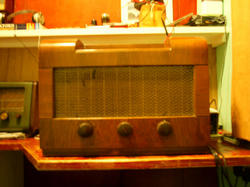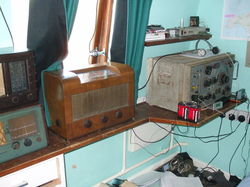The Boatanchors.
My rough-and-ready overworked sets.
Big... Heavy... Old... Fun!
This page is simply to show off the two scruffy valve sets in regular daily use. Each has needed various repairs and more than a little maintenance over time, but both continue to be faithful performers. A warm soldering iron is pretty much a requirement for running a vintage station!
Note: a valve set is missing from the below list. Phillips 206A of 1940 was deemed beyond repair, and the lw/mw/sw set has been reduced to chassis and body. Useful spares have been retained, and this set's chassis may soon be used as the basis for a home brew project.
List of received European SW pirate stations (In no particular order):
Radio Scotland International (1st ever pirate!)
Radio Ascona
Radio Atlantis.
Electric Radio
Weekend Music Radio (UK)
Radio Spaceman
Radio borderhunter
Radio Galaxy
Flux AM
Radio spaceshuttle International
Radio Bonofox
Radio Boomerang
Radio Mazda
Westcoast Radio
Orion Radio
Zender Acona
Radio Heintje
Sparks Radio
Mega Radio
Radio Devalon
Radio Bluehouse
Laser Hot Hits (UK)
Radio Zodiak
Skyline Radio International
Radio Paardenkracht
Radio Quintus
The Bogusman (UK)
Radio MERLIN International (UK)
Mystery Radio
Nevada Radio
Galaxy INTERNATIONAL (UK)
Cupid Radio
Radio Marconi
Radio Caroline Shortwave (UK)
Radio Bluestar
Radio Underground (UK)
Radio Saturnus.
Eastcoast Radio Holland
Voice Of The Netherlands
Britain Radio International (UK)
Radio Calypso ~ Calypso104 -at- hotmail.com
The current list as of March 2008. Many stations, such as WMR, Orion, Westcoast, Borderhunter etc are regulars. Others like Mazda and Devalon have only been heard once. The list can only get longer!
All stations received on the below set, using the transmitter antenna - unless it happens to be in use.
Audio logs: I try and update these logs as regularly as possible, and audio of received stations can be found here: http://ddraigcymraeg.deviantart.com/gallery/scraps
HMV 1120 = 1948
Its a woodie! Nothing like valve glow being reflected off polished walnut...
The HMV 1120, the first SW receiver I ever brought - for the costly sum of £15! The man was eager to get rid of it - it was big, heavy, and suffered terrible QRM in its then current location. So much, that he thought it was broken!
Well, I paid for it, then carried it around for three hours untill I could get the bus. As you can probably imagine, it got heavier with every step!
Still, once home I threw up a peice of wire to test it on, before re-alighning the IF stages. That done, I re-strung the tuning cord, polished it up, and it has worked fine ever since.
It has the usual LW and MW broadcast bands, + 15.5-100 meters SW and manages to resolve AM and CW transmissions with ease. It sees regular work in the Vintage and Military Amateur Radio Society 80 meter AM net, as well as being my workhorse for both 75/48 meter Europirates. At night it switches bands and monitors the Datatrak navigation signals on longWave, as well as various longwave NDB's.
R.107 - the BIG one.
The Receiver Mk.107 was the standard communications set of the second world war. Often found mounted in tanks and large vehicles for battalion communications, or as a fixed station back here in the UK. The power supply could be operated from either 12vDC or 240V mains. The set has sidetone and muting sockets, allowing it to be controlled remotely alongside a transmitter. The manual gives information on how to hook it up to the Mk.12 or type 33. transmitters for long range use. Under various roles the sets were used into the late 1950's and some went on even longer with Cadet units.
This particular example has seen some modifications since it's working days. Internally, the Vibrator pack for battery operation has been removed, and the mains power supply has been modified to include new rectifier valves after the original becam unobtainable. Alot of the wiring has been replaced and a removable S-meter can be inserted into the watch hole. Various graffiti adornes the case - some very obscure - " Pink is 7, black goes into red" - and some hinting at a past occupation - "2182KC/S". This is the current maritime topband distress frequency, so perhaps this set had a maritime monitoring role in it's past.
Whatever it's story, this set has now been set up in the shack as the primary receiver and has been running excellently. The set is highly sensitive and readily tuned up, once you get over the initial shock of all those controls. See the photo gallery for a 'full frontal' picture.

